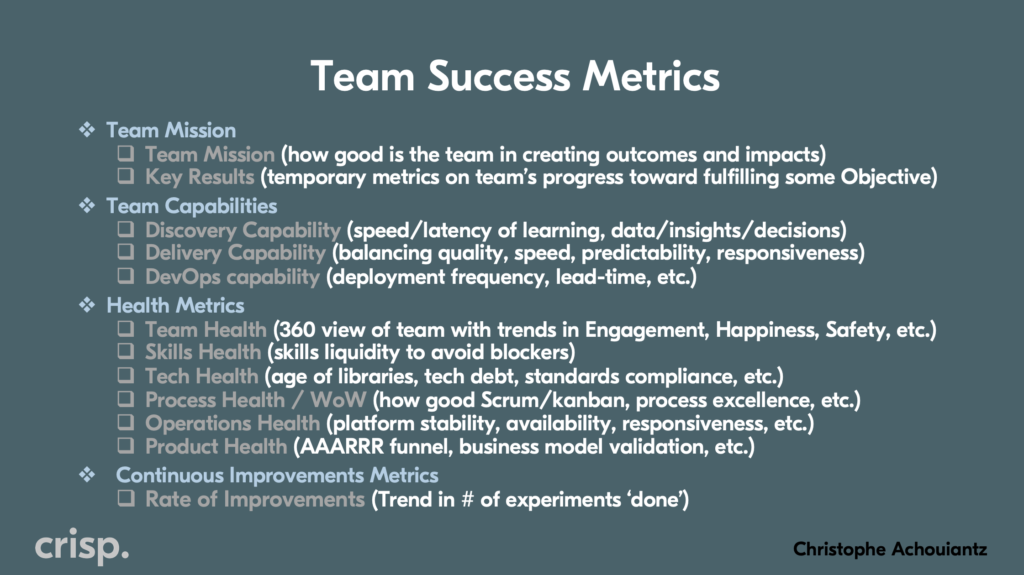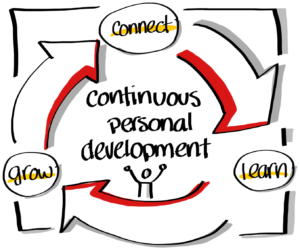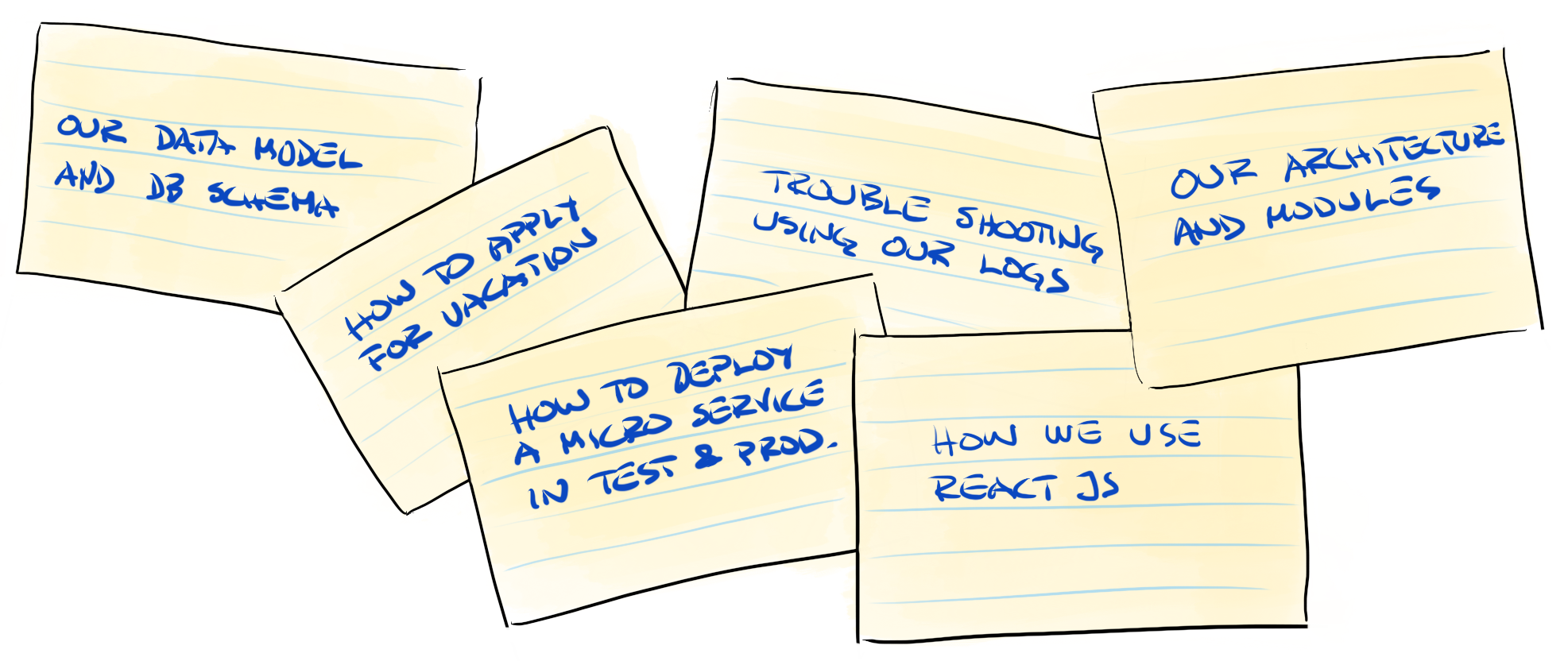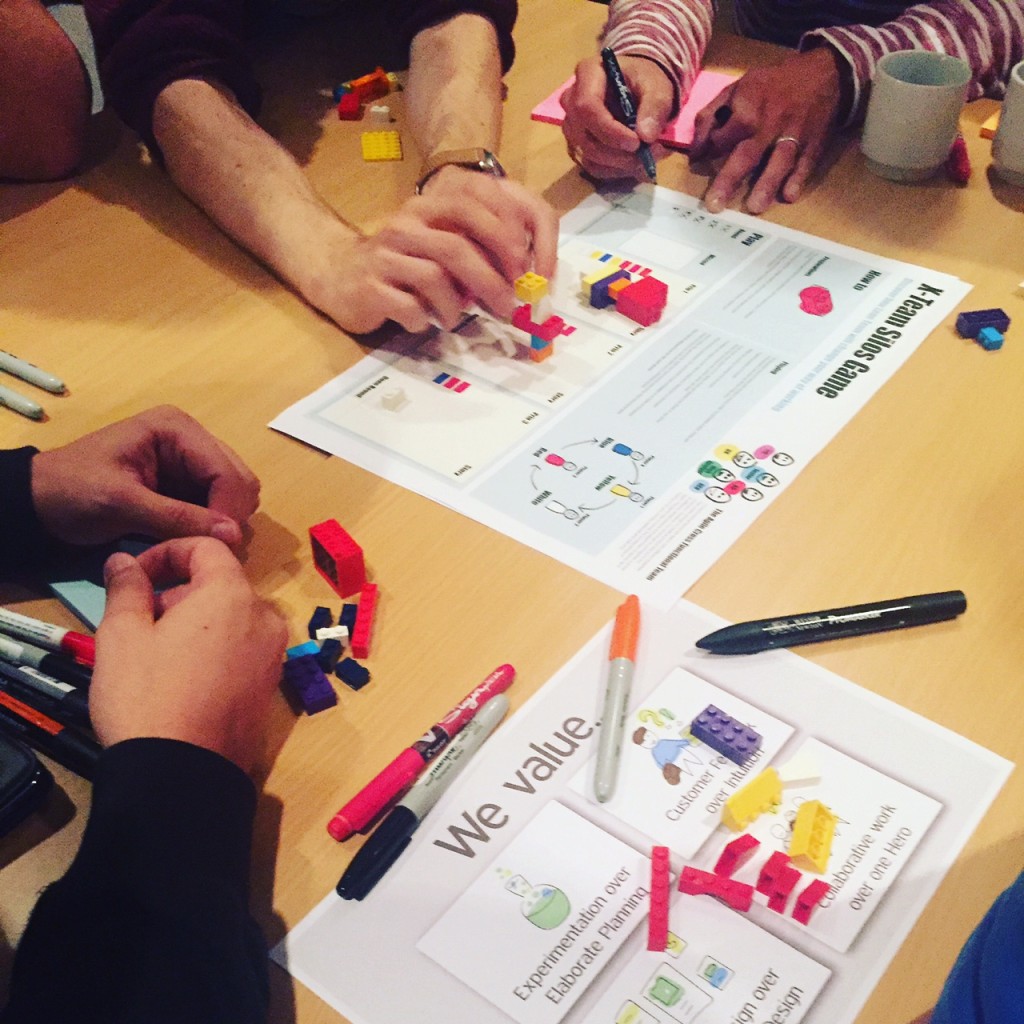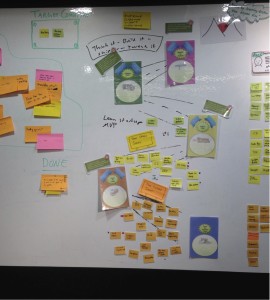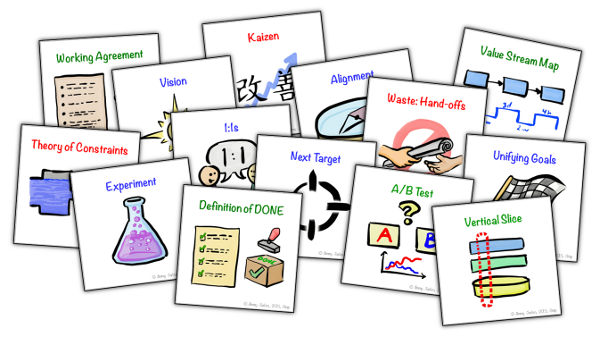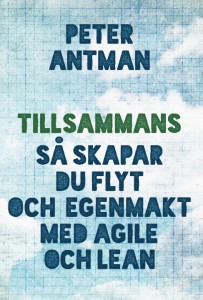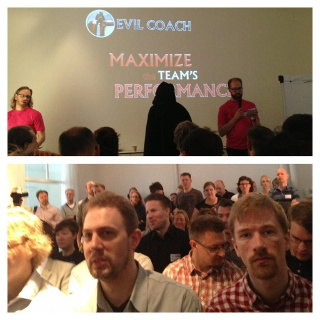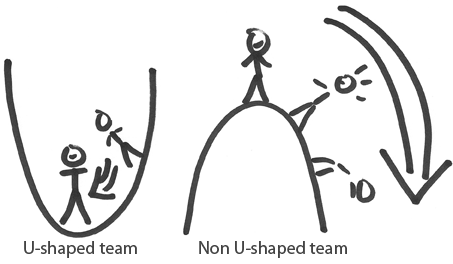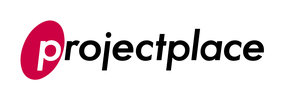Are we successful as a Team? Can we measure that? We look at 10+ areas of team success and how to measure them. Get inspired to choose the metric you need, right now, on your path to high-performing!
Continue readingFörutsättningar för en positiv grupputveckling
Jag utbildade mig nyligen till handledare för försvarshögskolans koncept Utvecklande Ledarskap (UL); fem mycket inspirerande och lärorika dagar. Förutom ny kunskap har jag dock också med mig upplevelsen kring kraften i grupputveckling när den blir som bäst. Under kursen satt och jobbade vi i kvarteret där vi både hjälpte varandra förstå kursinnehållet men också förberedde och genomförde en del av den normala UL-kursen inför övriga kursdeltagare. Det är fascinerande hur starkt relationerna inom en grupp kan utvecklas, och från det att en tydlig teameffekt kan växa fram, efter så kort tid som några få dagar.
Det fick mig att fundera på vad det var som hände under kursen som gjorde detta möjligt. Vid reflektionen kring hur utbildningen var strukturerad, den miljö vi befann oss i, handledarnas agerande och vad vi gjorde i kvartetterna, landade jag i att nedanstående fyra aspekter hjälpte oss till att formeras till kraftfullt team under veckan som gick:
- fokus på att bygga en trygg miljö,
- Vi hade väldigt tajta målsättningar att arbeta mot
- Det fanns möjligheten till frekvent feedback på de resultat vi skapade, samt vi gav varandra löpande feedback på varandras prestationer
- och vi var en liten och komplett gruppering som skulle lösa uppdraget tillsammans självständigt.
Continuous Personal Development
For the past four years I’ve consulted for King as an agile team coach. It’s been a whirlwind of personal growth, learning about mobile games and meeting awesome people. I wrote about my biggest takeaways in an article on Crisp’s website. I am grateful for all the connections and insights that I’ve gained. I’m also
Continue readingUX – It’s obvious, right?: Part 3
In the talk I gave at Agila Sverige in June, I brought up misconceptions about UX I’ve encountered during my years in the IT business. One of these is that it’s only the UX people (and possibly the PO) who need to meet the users. In this post I’ll discuss why this not true, but also how meeting the users can make a real difference in focus and motivation for the team.
The Training Deck – how to onboard a new team member faster
There will always be a productivity dip for the team when a new member joins. The question is not if it is going to happen, but how much will productivity dip and for how long. Imagine if you could onboard new team members with a minimum of productivity loss.
Transforming the pyramid to an agile org
I recently published a video exploring how an agile team based organization could look like. How does it function under the hood? In the video I also discussed how you get there.
I got tons of great feedback so I decided to provide the contents of the video in the format of a blog. If you prefer to read instead of watching a 11-minute-long video, then this is for you 🙂
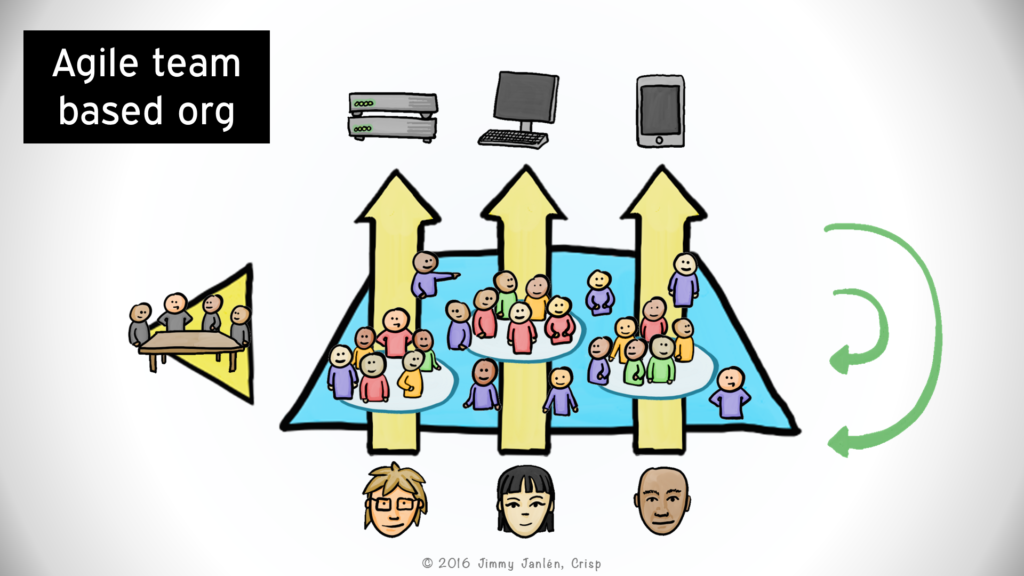
X-team Silos Game – getting in T-shape
Cross functional teams are complete in expertise but not necessarily collaborative. Sometimes team members hold on to their expertise too much and the team does not perform to its potential. This Lego game illuminates the difference when members allow themselves to take on tasks outside their expertise, being so called T-shaped. Play the game to kick-start your change and create collaboration.
Better meetings with the Core Protocols

Good meetings is very much about achieving deep collaboration. But collaboration is often hard. We go into meetings with different modes, intentions, and expectations. How can we make meetings both more fun and energetic? Surprisingly enough: maybe by being more formalized.
Continue reading
Fluent@agile – visualizing your way of working
Help your team improve by visualizing their way working with the fluent@agile game. With the game you can help a team find out where it is on its agile journey and help it find new ways of both fine tuning and make leaps in their daily agile practices.
Me and Christian Vikström made the game together at Spotify during the spring 2014 when we were coaching and helping team to improve their agile skill sets and processes.
At Spotify the teams owns their own way of working. A team is basically only accountable to itself. We therefore needed an coaching tool that could help team take ownership of their self image and improvement strategy.
We also wanted the tool to be opinionated. It should be normative, tell what’s good and not, what kind of practices and behaviour that’s expected and not. But at the same time it should be open to new ideas, new practices and the teams local conditions.
Continue reading
Agile Topics card deck
The other week I got the idea to create simple conversation cards. Each card represents an agile practice, a conversation topic or an abstract theory. Now I’ve drawn 96 cards. I simply couldn’t stop 🙂
Tillsammans – så river programmerarna företagspyramiderna
I år hade jag äran att i anslutning till Agila Sverige (2015) släppa Riv pyramiderna igen som riktig bok med den mycket bättre titeln Tillsammans – så skapar du flyt och egenmakt med agile och lean (tack till Joakim Holm för att du övertalade mig att negativa titlar är dåliga). Den hemliga undertiteln tycker jag
Continue readingMy Spotify tools
Last week i quit my assignment at Spotify. I was there to help and act as a stand-in for Joakim Sundén while he was on paternity leave. He’s now back in the saddle as Agile Coach in the More Than Music Tribe. I had the pleasure to work closely with the Agile Coach Christian Vikström on Spotify and together we have been coaching the Browse, Growth and Customer Support squads. A was also a member of the tribe management team, and together we did some new interesting stuff.
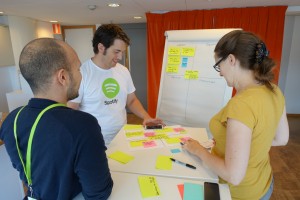
It’s has been fascinating and fantastic to work with such dedicated people and a product that has such a traction. Spotify is also really trying to build an awesome and agile organization and culture that can win and sustain in the long run. What is there to do at such a fantastic company? That’s a reasonable question. A lot I discovered. Spotify is shock full of super smart people, but many of them has not worked there for long, many of them has not worked long at all, teams have been newly formed and are under constant change. Simply put: even Spotify needs a lot of basic agile coaching.
When I now look back at what we did during these last 8 month I see a lot of tools and experiences that I think others also can find useful. During the next couple of month I will share them through this blog. Hope you will find them useful. Here’s the planned list:
Consensus slides and speech from Agila Sverige 2014
At Agila Sverige 2014 I talked about consensus, what it is, why it is the basis for creating good and strong decisions that is often already implemented when the decision is finally made. I also talked about the hand signals we use at Crisp to manage our consensus decision process (read more about it here).
Here’s my slides, that contains more on howto facilitate consensus decision making:
Continue reading
Role Expectation Mapping
Role Expectation Mapping is a series of workshop that explores, clarifies and establishes which expectations members of a group, team or project have on each other.
If you suspect that collaboration is undermined because of mismatch of expectations between people, then this exercise could boost the team’s ability to collaborate efficiently together. It is also a powerful way to jump start a new team and give them a structure to relate to.

People always have certain expectations on each other, behaviors, responsibilities, etc., but if those aren’t made clear and agreed upon among everyone – you are bound to have unconstructive conflicts, colliding agendas, difficulties in collaboration and things that fall between chairs.
Team barometer (self-evaluation tool)
Sometimes it’s hard for a team to know if they get tighter and better as a team over time. This is a tool that allows a team to learn just that.
Team barometer (self-evaluation tool) in a nutshell
The barometer is executed as a survey in a workshop. The survey consists of 16 team characteristics, packaged as a deck of cards. Team members vote green, yellow or red for each card in the meeting (or before the meeting as an anonymous survey). Once all cards have been run through, the team reflects and discusses the results. You can, if you want to, run through the exercise in thirty minutes, but I recommend to set aside an hour.
Det är inte bara din ScrumMaster som behöver förstå vad “agile” är!
Återigen har ni diskussionen om “working software over comprehensive documentation” verkligen betyder att man inte behöver dokumentera någonting alls. Eller diskussionen om det är ok att förlänga sprinten med några dagar för att hinna klart den sista fixen på den där storyn. Eller diskussionen om vad det egentligen innebär att vara “lean”. Känner du igen dig? Kan det vara så att alla har nytta av att ha samma grundförståelse av centrala begrepp i och runt “agile”? Läs vidare för ett enkelt sätt att skaffa den kunskapen!Continue reading
Kompetens i det dagliga arbetet
Finns nu i bokform på Leanpub
Kompetens i det dagliga arbetet
Detta är avsnitt två i delen om Ny kunskap - ett gemensamt ansvar i serien Agil HR from the trenches
Kompetensspridning via team
Låt oss börja med att ställa några ledande frågor:
- Arbetar ni i team som innehåller alla kompetenser som krävs för att leverera slutprodukten?
- Är det tillåtet (och helst uppmuntrat) att jobba tillsammans med en uppgift (till exempel parprogrammera)?
- Får team arbeta med saker då och då som de inte kan innan (ny domän, ny teknologi)?
- Kan man (kanske inom rimliga gränser) själv välja vilket team (och därmed område) man vill arbeta i?
Om du svarar ja på alla dess frågor kan du antagligen gå vidare till nästa avsnitt direkt. Om du svarar nej på samtliga, då skulle jag gissa att du både har stora utmaningar att alls leverera saker och att få till utveckling av yrkeskunskap på jobbet. Det kommer också vara ytterst svårt, eller omöjligt, att kompensera den sorts evigt pågående kompetensutveckling som uppstår ur att organisera arbetet på ovanstående sätt med andra former av åtgärder.
Continue reading
Evil Coach LIVE! “Maximize the Teams Performance”
During the conference Agila Sverige 2013, I – the Evil Coach – made my first public appearance. I gave a lightning talk on how to maximize the team’s performance. The room was filled to the brim. The talk ended with standing ovations which were immediately followed by an early termination of the conference since no one could possibly
Continue readingSläng titlarna
Finns nu i bokform på Leanpub
Detta är den fjärde posten i en serie om agil HR “from the trenches”.
Del 1: Continuous investment
Del 2: Lägg ner utvecklingssamtalen
Del 3: Lön är rättvis ersättning – inte belöning
Del 4: Släng titlarna
Del 5: Ny kunskap – ett gemensamt ansvar, avsnitt 1
Del 6: Hitta rätt folk – släpp dem lös
Släng titlarna
Låt oss börja med två okontroversiella påståenden: Företag bygger på vertikala hierarkier och horisontell specialisering Ok?
Låt oss ta det en gång till.
Företag är hierarkier. Jag skriver här medvetet företag och inte organisationer i största allmänhet. Huruvida organisationer måste vara hierarkiska låter jag nämligen vara en öppen fråga, men företag är hierarkier, per definition.
Det finns förvisso många olika teorier om varför företag finns, men i princip alla går ut på att förklara varför människor som utför aktiviteter på en marknad “väljer” att karva ut en bit av denna ekonomiska aktivitet och där slopa marknadsmekanismerna.
Huruvida skälet till detta är att det minskar transaktionskostnaderna, eller att det löser problem med så kallade externa effekter (marknadsmisslyckanden), eller för att det ökar effektiviteten i hantering av olika egendomar, eller för att det ger makt att hantera ekonomiskt överskott, eller att det helt enkelt ligger i den mänskliga naturen att dominera andra, spelat för vårt resonemang här ingen roll.
Poängen är att kärnan i företag är att någon (företagaren) skriver långsiktiga kontrakt med en eller flera (anställda) som avsäger sig vissa av sina friheter för att i stället bli företagarens agenter. Som en av pristagarna till Sveriges Riksbanks pris i ekonomi till Alfred Nobels minne sammanfattar: Företagaren “försöker utforma avtal med agenterna som ska stimulera dem att öka hans vinst, och han kontrollerar deras prestationer”.
Eller som Henry Ford uttryckte det i lite mer klartext: “Jag tänker betala er tillräckligt mycket för att ni ska finna det värt att acceptera mina diktat i jobbet”.
A team experiment with and without offshoring
A cross-functional team I was working with last year had three testers offshore in India. The rest of the team (about 15 people) was co-located here in Stockholm.
Some team members had a nagging feeling that they could go so much faster if the testers also moved to Stockholm so they went to their boss and asked. The reply was that testers are so much less expensive, by a factor 2.3, so it was not possible, unless they could settle with fewer testers.
So they decided to do an experiment for a few months. They moved one of the testers from India to Stockholm and dropped the other two testers (re-allocating the other two to other teams) to see how that would work.
Lön är rättvis ersättning – Agil HR i praktiken
Finns nu i bokform på Leanpub
Detta är den tredje posten i en serie om agil HR “from the trenches”.
Del 1: Continuous investment
Del 2: Lägg ner utvecklingssamtalen
Del 3: Lön är rättvis ersättning – inte belöning
Del 4: Släng titlarna
Del 5: Ny kunskap – ett gemensamt ansvar, avsnitt 1
Del 6: Hitta rätt folk – släpp dem lös
Lön är rättvis ersättning – inte belöning
Så här är alltså läget: Vi har lagt ner utvecklingssamtalen och allt arbete sker i team där deltagarna tar gemensamt ansvar för sitt arbete och resultat. Då reser sig förstås frågan: hur sätter man lön i en sådan organisation? Ingen enskild prestation, ja, egentligen inte ens ett enskilt (synligt) ansvar finns ju att bedöma och ersätta eller belöna. Och inte heller har vi ett samtal där medarbetarna (lite i hemlighet) kan bedömas. Svårt läge.
Tyvärr är det värre än så.
T-shaped people and U-shaped teams
I guess you have heard about T-shaped people, that is, people with deep skills within one or a few areas combined with some knowledge in many areas.
Now it’s time to introduce U-shaped teams. That is, teams that are balanced and where teammates are helping each other. It’s a team where you might have a bad day and are allowed to fail without causing consequences. It’s where the teammates help you get back to normal and what’s more make you feel comfortably included in the team. Your team becomes your safety net and it’s the place where you can dare to be vulnerable. U-shaped teams are also good for productivity since safety means productivity. *
What questions does your Working Agreement answer?
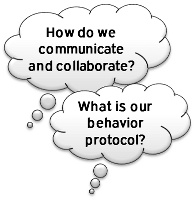 All teams have some sense of what is regarded as acceptable or good behavior within the team. Most people know that colleagues don’t appreciate it when you’re late. Perhaps you have a silent agreement regarding how you vote and make decisions. Some teams write down their behavior and collaborative “protocol” in a Working Agreement.
All teams have some sense of what is regarded as acceptable or good behavior within the team. Most people know that colleagues don’t appreciate it when you’re late. Perhaps you have a silent agreement regarding how you vote and make decisions. Some teams write down their behavior and collaborative “protocol” in a Working Agreement.
You might think that common sense covers it and writing it down seems silly, but surprise – common sense is subjective and you will have different opinions about things. Great! Let’s discuss and find our common ground.
The act of discussing it and writing it down is also a strong team building activity and forges relationships between team members. Any new team, or any team for that matter, could benefit greatly from a one-hour workshop. It could be part of a retrospective or a stand-alone meeting.
Five team principles
Building a well-functioning software delivery team is complicated. There are many factors to consider. Current team (if any), needed skills, available people, company politics etc.
There are some fundamentals that often (but not always) seem to work.
My fundamental principles for teams
- Static
- Cross-functional
- 5-9 people
- Co-located
- Dedicated team members (belong to only one team)
I find these principles to be a useful basis for discussion, when helping managers configure their teams.
The principles are goals, and one must realize that all cannot be achieved all of the time, nor instantly.
Case Study of Mobile Team at Projectplace
I am currently working as a Scrum Master for multiple teams at Projectplace in Stockholm, Sweden. One of those teams is the Mobile Team. They are developing Action Boards for both iOS (iPad) and Android platforms. These Action Boards are also available in the Customer Preview of the Projectplace web service. Both Web Team and Mobile Team share the same API’s. The iPad app is planned to be released in 2-3 Sprints from now.
This case study can be written from many perspectives, but in this article I am going to focus on how we are working with the challenges of having a distributed Scrum team.
A professional mindset
Is this years final series in the Swedish hockey league, there is one team that standing out from the crowd. They are more stable, persistent and thorough in every part of their game than the other teams.
Today I stumbled over this comment from one of the players. It highlights a mindset I have seen in both software and sports team that basically felt unstoppable.
"If I am going to think about this victory on the way home? No. I am only going to think about the details that is going to make us better in the next game"
– Jimmie Ölvestad
Emo-lines
If you coach a scrum team but you’re not around to observe them during the sprint, how do you know how they felt about it?
Use Emo-lines
The responsibility model
At the Lean Software conference in London Portia Tung tipped me off about Christopher Avery’s responsibility model. I need to show it to you.
- Denial – ‘Problem? What problem? There’s no problem.
- Blame – ‘I don’t have a problem working with you. You seem to have a problem with me. That makes it your problem. ‘
- Justify – ‘I guess it’s possible that I’ve become insensitive to other people’s feelings and needs. I can’t help it though. After all, I’ve been doing this job for a long time. It’s who I am.’
- Shame – ‘What have I done? I’m going to look such an idiot in front of the people at work. How am I going to live it down? Why should they help me after the way I’ve behaved?’
- Obligation – ‘Tell me what you think I should do. I have no choice but to do it (even though I don’t want to). I’ll do whatever you say. It’s only a job after all (no one can expect to do a job they love).’
- Responsibility – ‘I can wait for them to change but that could take forever. No, it’s up to me. I want to fix the problem. So how am I going to be a better colleague? I know! I’ll listen more. And be more considerate towards others. It’s a start.’
Now test yourself – just how professional are you?
Continue readingKanban checklists
These are checklists I have compiled to help my Kanban teams stay focused
|
 |
My favourite top 5 Agile team rules
Building something common out of high performing individuals is not always easy. Here are my favourite five Agile team rules:
- Best idea prevales! "No" – is allowed, if you can come up with something better
- Steady progress beats tripping and falling over
- Bad news first
- In order to lead an army, you have to be able to lead a group. In order to lead a group, you have to be able to lead yourself
- Is it better to be right or to be helpful?
The day I know I have succeeded with Agile? -The day I am out surfing 🙂
Continue reading